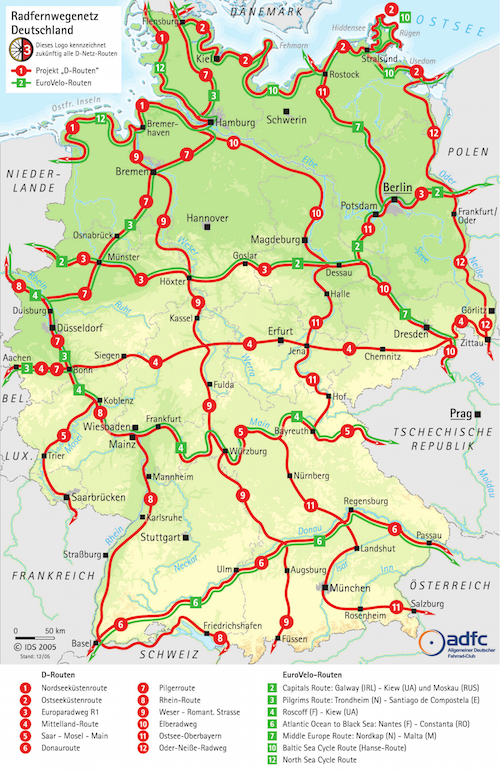Radnetz Deutschland
As part of my series of posts about road maps, I recently reviewed the collection of cycle maps ADFC Radturenkarten. Doing so, I came to discover the existence of the German national bike network Radnetz Deutschland also called Radnetz, dnetz or D-netz and depicted by the  logo.
logo.
According to Wikipedia, this network of 12 routes has been launched in 2002 as part of the National Cycling Plan and its development should continue at least until 2020.
Being clever, the Germans decided to exploit the synergies with the European network EuroVelo, which started in the 1990s. The international network is de facto incorporated in the German one: route  follows
follows  , route
, route  is route
is route  , etc. And – what a surprise! – the seventh route of the network, Die Pilgerroute, is the German counterpart of EuroVelo 3, The Pilgrims’ Route.
, etc. And – what a surprise! – the seventh route of the network, Die Pilgerroute, is the German counterpart of EuroVelo 3, The Pilgrims’ Route.

The German national bike network is taking advantage of the European network, EuroVelo. Being quite central in Europe, Germany is indeed crossed by 8 EuroVelo routes out of 15 - only 7 in 2002 when this poster was made. This is an absolute record, more than France with 7 routes and than Poland with 5.
That said, for a network started in 2002, I must say I am not impressed with the result. After more than 10 years, Wikipedia states that “in North Rhine-Westphalia, routes 3, 4, 7, 8 and 9 have been marked” (source, my traduction). Does it mean that the other routes haven’t been marked? If I focus only on route  , the dedicated Wikipedia page says that “the route is partly marked with the D7 logo, but also partly marked with just local direction signs” (my traduction). Brunaud Devillard from
, the dedicated Wikipedia page says that “the route is partly marked with the D7 logo, but also partly marked with just local direction signs” (my traduction). Brunaud Devillard from  – who rode from Copenhagen to Paris last summer – confirmed that
– who rode from Copenhagen to Paris last summer – confirmed that  is mainly unsigned.
is mainly unsigned.
dnetz’s website gives also a weird feeling: the news, the Twitter or the Facebook page all stopped publishing between May and November 2012. Information about the advancement of the network can surely be found as part of the 2012-2020 National Cycling Plan. But unfortunately, both are in German, and my level of German is too limited to understand administrative or technical considerationsIf this is not a problem for you, here is the 2012-2020 National Cycling Plan as PDF. Please share your findings with me!.
But the good news is that dnetz’s website provides the GPS track of each route of the network. As you may know, I am in the process of building a journey planner for The Pilgrims’ Route. The GPS tracks from Radnetz are probably a few years old, but it is worth trying to read them, waiting for an even better source of dataI have now (03/06/2016) found an extensive track for the whole Pilgrims’ Route on Biroto.. You can follow me in that exciting importation adventure in a next post.
